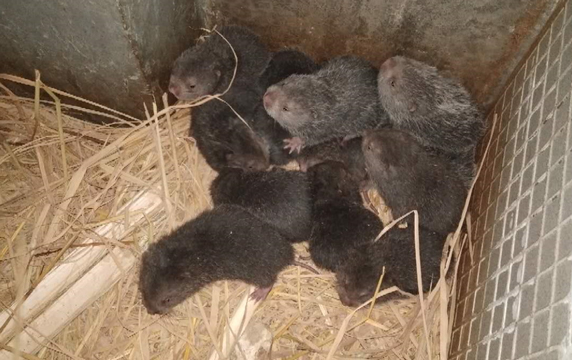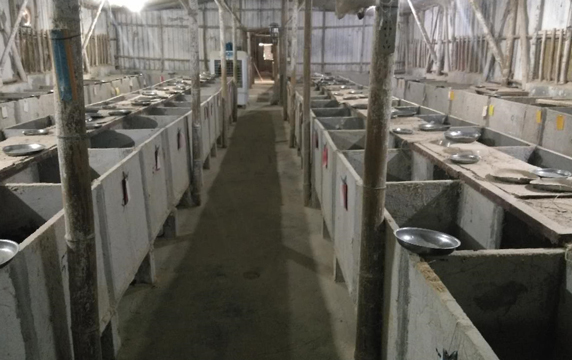November 5, 2020 — Editor’s note: This feature, part of a collection of stories around reducing the threat of wildlife-transmitted disease, is supported by funding from the Solutions Journalism Network. Some of the quotations in this piece were translated with the assistance of Jonathan Zhong.
Nearly a year ago, somewhere in China, a previously unknown virus made its way from a wild animal into a human host. There it found not only a hospitable home, but also an opportunity to spread trillions of copies of itself, eventually replicating to become the global Covid-19 pandemic.
That outbreak, now having infected more than 46 million people around the world, has been the impetus for a series of actions taken by the Chinese government to — in theory — get a handle on zoonotic disease outbreaks now and in the future.
A first step, taken in February and later solidified through regulations, largely banned commercial breeding of terrestrial wildlife for meat consumption as part of a series of actions meant to reduce those risks.
Also forthcoming: an updated version of the country’s Wildlife Protection Law, an amended Animal Epidemic Prevention Law and a new Biosecurity Law. These efforts are all part of a raft of measures China’s leadership is in the process of rolling out to address the potential for zoonotic diseases moving from animals humans. The hope is that these frameworks will help reduce the possibility of future pandemics like Covid-19.
The picture on the ground, however, presents mixed signals. Some progress has been made in shutting off much of the formerly robust wildlife trade related to meat consumption. But virtually nothing has been done to address potential threats from fur farms and operations raising wildlife for use in Chinese pharmaceuticals, leaving open the potential for fur and pharmaceutical operations to be a future source of zoonotic diseases like Covid-19. It also increases the potential for these industries to serve as a hub for illicit wildlife trade.
Devastating Bans
Bans on consumption of meat from wildlife first started as temporary measures early in 2020. They soon morphed into regional and national regulations and will eventually be fully entrenched in laws currently being drafted or revised. The first of those, the updated Wildlife Protection Law, is in the final stages of being amended, and will likely be passed in the coming months.
For many farmers, these changes have been devastating. Over the past several years local governments had provided loans, and forestry bureaus and other departments had given out permits for farmers to breed a wide range of wild animals for meat, fur and parts used in traditional Chinese medicine.

Bamboo rats being raised for food were slaughtered en masse earlier this year to help reduce future pandemic risk — while other wild animals raised for fur and medicine were not banned by government edicts. Photo courtesy of Michael Standaert
In 2017, a report by the Chinese Academy of Engineering valued the wildlife-farming industry at ¥520 billion (US$77 billion), including those raised for meat, fur and medicine. Traditional Chinese medicine in particular is big business and a huge draw for wildlife farming. While the wildlife trade has been encouraged for years, it became even more prominent after being enshrined in Document No. 1 issued by the State Council at the start of 2018, which stated “wildlife domestication” would be a primary means for developing the rural economy. Bamboo rats, civet cats, raccoon dogs, porcupine, snakes, turtles, several varieties of deer and more all were pushed as a means for rural farmers to help lift themselves out of poverty under Chinese leader Xi Jinping’s poverty alleviation campaign, set to culminate this year.
But by the end of February 2020, at least 20,000 farming operations had been shut down in just eight provinces, with estimates that the number nationwide could be over 100,000, though no official figures have been released.
Four years ago Li Xinhua, a farmer in the small village of Shebu on the south bank of the Dong River in eastern Guangdong province, built a facility to raise around 300 bamboo rats for meat as a way to keep his elderly mother occupied. Since he was not a member of a government-designated “poverty household” and so ineligible for grant money, he’d spent ¥200,000 (US$30,000) of his own savings to build the small barn, purchase baby rats and buy the bamboo for them to eat over the four years it takes to raise them to maturity.

Countless facilities for raising bamboo rats stand empty in the wake of Chinese government initiatives to reduce the threat of zoonotic disease from farmed wild animals. Photo courtesy of Michael Standaert
Once the bans came down he was ordered to stop selling the rats for food. Li says local government officials showed up a couple of months ago, took the rats away and buried them alive.
“We’ve all had to dispose of our animals,” Li said through an interpreter over tea on a recent visit to his farm. “Since I’m not a poverty household, we only got a little compensation.”
Another farmer, Mr. Liu — who declined to give his full name after he says he was harassed by local police who told him to stop talking “nonsense” to journalists — had raised bamboo rats for 11 years in an area about 25 miles (40 kilometers) north of Li’s farm. He recently found himself in a similar predicament: Like Li, he couldn’t register as a poverty household, so he was allowed little compensation.
Just a year ago, Liu was able to get a loan of ¥100,000 (US$15,000) from his local government, but he also needed to invest more than ¥500,000 (US$75,000) of his own money in the operation. Under the new pandemic prevention laws, he was only able to get ¥97,000 (US$15,000) as compensation for culling the rats, he says, leaving him severely in debt and unsure of what to do next.
“Over 10 years of savings and hard work gone overnight,” Liu says. “I’ll just have to start over.”
Counties like Heyuan, where the two farmers live, are trying to ease the transition to other enterprises by providing training and loans to start up operations such as growing mushrooms or chickens, or even brewing beer. But for those interviewed for this story, the process is slow and uncertain.
“Transition my ass,” wrote one bamboo rat farmer from Guangxi in South China in a private chat group with several hundred other wildlife farmers across the country. “I’m in huge debt and now have to work my ass off to get out of it.”
Haphazard Formulation
Aron White, a China specialist and wildlife campaigner with the Environmental Investigation Agency (EIA), says that despite some of the problems with the rollout leading to inconsistent compensation and hardships for former breeders, the ban on consumption of terrestrial wildlife has been a positive step toward more precautionary approaches by the government. But, White says, such an approach should not be limited to raising animals for food, but instead should also apply to industries such as fur and traditional medicine.
As long as he didn’t sell them for meat, Li could have kept breeding bamboo rats with little to no biosecurity measures in place to prevent disease transmission to himself or to other animals. And it’s still legal to raise wildlife for other uses, including fur and traditional medicine. In fact, the government has now encouraged some breeders to switch from raising animals — for example, snakes — for meat and instead raise them for medicinal uses.
“In terms of the impact on a species or in terms of potential risks from crowding of animals into one space and potential contacts between animals and people, in many ways the risks would presumably be quite similar,” White says. “It’s been a real shame that we haven’t seen that precautionary approach across the board.”
If China does not tackle zoonotic disease seriously and systematically, say advocates of the One Health approach to simultaneously protecting the health of animals, people and the environment, future outbreaks stemming from the wildlife trade or captive breeding are certain. Some could have devastating global impacts.
Mohamed Ezzat El Zowalaty, a veterinary scientist and microbiologist at the University of Uppsala in Sweden, says that cultural perspectives are one of the main issues countries have in combating emerging infectious diseases. Those perspectives lead to incongruities between how scientists say we should reduce the risks of those diseases and the policies used to address them.
“We can say there’s no real strict implementation of biosecurity, and even if some of those strict protocols are there, there can be violations,” he says. “One of the answers to China’s [specific problems] is all the factors combined: the environment, the huge [animal and human] populations, and population density that allows the infectious agents to transmit easily and cross species between animals and people.”
Hope for Change
Li Binbin, assistant professor of environmental science at Duke Kunshan University in Jiangsu Province, says that further changes could be on the way. Revisions to China’s endangered species lists could remove more species from usable categories, such as fur farming and traditional medicine, in the future.
“That was a loophole that previously existed for a long time,” she says. “A lot of species that should have been protected were not there. So hopefully that will help include species — for example, how bats are protected, and how the protections might change.”
Li Binbin says the lack of biosecurity standards for captive breeding of different species of wildlife in China has led to the “ban it all” approach for terrestrial wildlife that can be consumed for meat or the movement of a handful of species to an allowable livestock list.
“So for wildlife, what can be farmed right now is on a special list,” Li says. “Now what they are doing is trying to find out the [biosecurity] standards for these species. The bans look harsh, but it works for China. We do not have enough data or information to evaluate which species [are] really safe and what is a sustainable way to use them. Sustainable use really depends on having an effective management system, but there are a lot of [bureaucratic] overlaps and there are gaps in the system.”
Related Posts
Ensia shares solutions-focused stories free of charge through our online magazine and partner media. That means audiences around the world have ready access to stories that can — and do — help them shape a better future. If you value our work, please show your support today.
Yes, I'll support Ensia!




